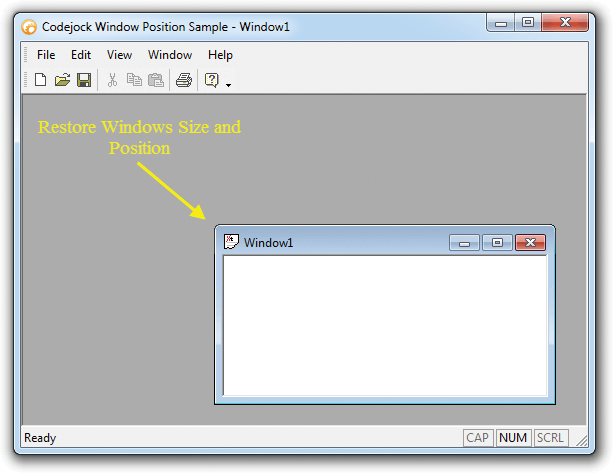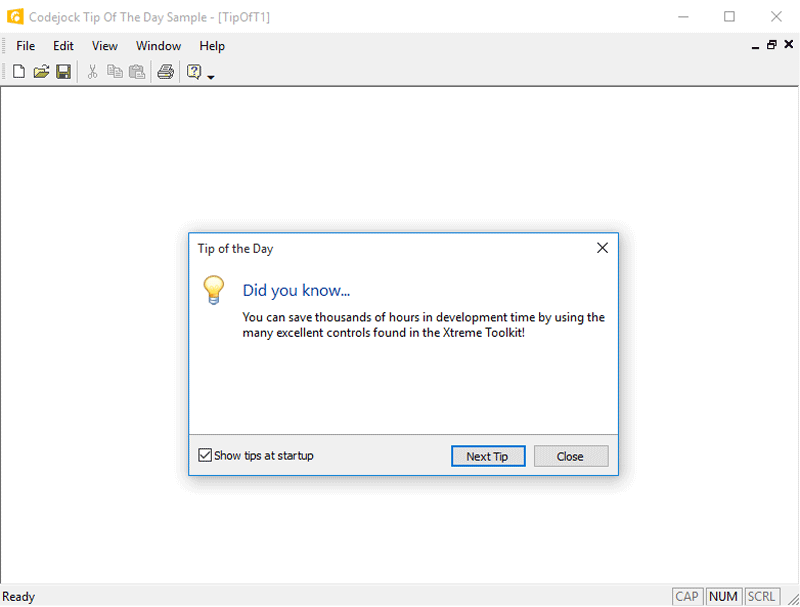

UINT cyVScroll // Height of scroll bar arrow. RECT rcClient // Client area of parent window (Dialog Box). INITCOMMONCONTROLSEX icex // Structure for control initialization.Ĭonst UINT valMin=0 // The range of values for the Up-Down control. Name = '-Controls' \ĭeclare handles to the up-down control and to its sibling controls, and forward reference the functions that initialize and create the controls. #pragma comment(linker,"\"/manifestdependency:type = 'win32' \ #pragma comment(lib, "C:\\Program Files\\Microsoft SDKs\\Windows\\v7.1\\Lib\\ComCtl32.Lib") Instructions Step 1: Add References to the Common Controlsīesides adding a preprocessor directive to include the common controls header file, you must also configure the linker to reference the latest version of the common controls library.
CODEJOCK UPDOWN CONTROL EXAMPLE CODE
The code example featured in this topic uses an up-down control to drive a progress bar. You should use the CreateWindowEx function instead. Note The CreateUpDownControl function is deprecated.
CODEJOCK UPDOWN CONTROL EXAMPLE WINDOWS
If (!int.TryParse(txtNum.You create up-down controls by calling the CreateWindowEx function and passing the value UPDOWN_CLASS for the Windows class parameter lpClassName. Private void TxtNum_TextChanged(object sender, TextChangedEventArgs e) Private void CmdDown_Click(object sender, RoutedEventArgs e) Private void CmdUp_Click(object sender, RoutedEventArgs e) Public partial class TemplateNumericUpDown : UserControl / Interaction logic for TemplateNumericUpDown.xaml TemplateNumericUpDown.cs using System.Windows The running NumericUpDown from Micheal with modification will be as below:. I use MaterialDesign Theme from Nuget to get the Chevron icon and button ripple effect. I do it as UserControl where I can drag and drop like a Controls elements. Void scrollBar1_ValueChanged(object sender, RoutedPropert圜hangedEventArgs e)Īpologize for keep answering 9 years questions. ScrollBar1.ValueChanged += new RoutedPropert圜hangedEventHandler(scrollBar1_ValueChanged) This.Loaded += new RoutedEventHandler(NewProjectPlan_Loaded) Here is the original snippet from my code.

Then in the event handler, add: void scrollBar1_ValueChanged(object sender, RoutedPropert圜hangedEventArgs e)įteHolderText.Text = () In the constructor, define an event handler for the scrollbar: scrollBar1.ValueChanged += new RoutedPropert圜hangedEventHandler(scrollBar1_ValueChanged) In your code behind, add the following code: Use VerticalScrollBar with the TextBlock control in WPF. If (decimal.TryParse(baseValue as string, out _)) return baseValue Private static object CoerceDecimalValueProxy(DependencyObject d, object baseValue) New FrameworkPropertyMetadata("0", FrameworkPropertyMetadataOptions.BindsTwoWayByDefault, null, CoerceDecimalValueProxy)) Public static readonly DependencyProperty DecimalValueProxyProperty =ĭependencyProperty.RegisterAttached("DecimalValueProxy", typeof(string), typeof(InputLimit), This enables animation, styling, binding, etc. Using a DependencyProperty as the backing store for DecimalValueProxy. Public static void SetDecimalValueProxy(TextBox obj, string value) => obj.SetValue(DecimalValueProxyProperty, value) Public static string GetDecimalValueProxy(TextBox obj) => (string)obj.GetValue(DecimalValueProxyProperty) If you want apply input restrictions on TextBox indeed, try this: public static class InputLimit Here is a Style of Slider as a NumericUpDown, simple and easy to use, without any hidden code or third party library. Private void btdown_Click(object sender, RoutedEventArgs e) Private void btup_Click(object sender, RoutedEventArgs e) _DownButton = Template.FindName("PART_DownButton", this) as RepeatButton

_UpButton = Template.FindName("PART_UpButton", this) as RepeatButton "Step", typeof(int), typeof(IntegerTextBox), new UIPropertyMetadata(1)) Public readonly static DependencyProperty StepProperty = DependencyProperty.Register( Typeof(Button).GetMethod("set_IsPressed", BindingFlags.Instance | BindingFlags.NonPublic).Invoke(NUDButtonUP, new object NUDButtonUP.RaiseEvent(new RoutedEventArgs(Button.ClickEvent)) Private void NUDTextBox_PreviewKeyDown(object sender, KeyEventArgs e) NUDTextBox.Text = Convert.ToString(number - 1) If (NUDTextBox.Text != "") number = Convert.ToInt32(NUDTextBox.Text) Private void NUDButtonUP_Click(object sender, RoutedEventArgs e) This is example of my own UserControl with Up and Down key catching.Īnd the code: public partial class NumericUpDown : UserControl If (!int.TryParse(txtNum.Text, out _numValue)) Private void txtNum_TextChanged(object sender, TextChangedEventArgs e) Private void cmdDown_Click(object sender, RoutedEventArgs e) Private void cmdUp_Click(object sender, RoutedEventArgs e) And the code behind private int _numValue = 0


 0 kommentar(er)
0 kommentar(er)
